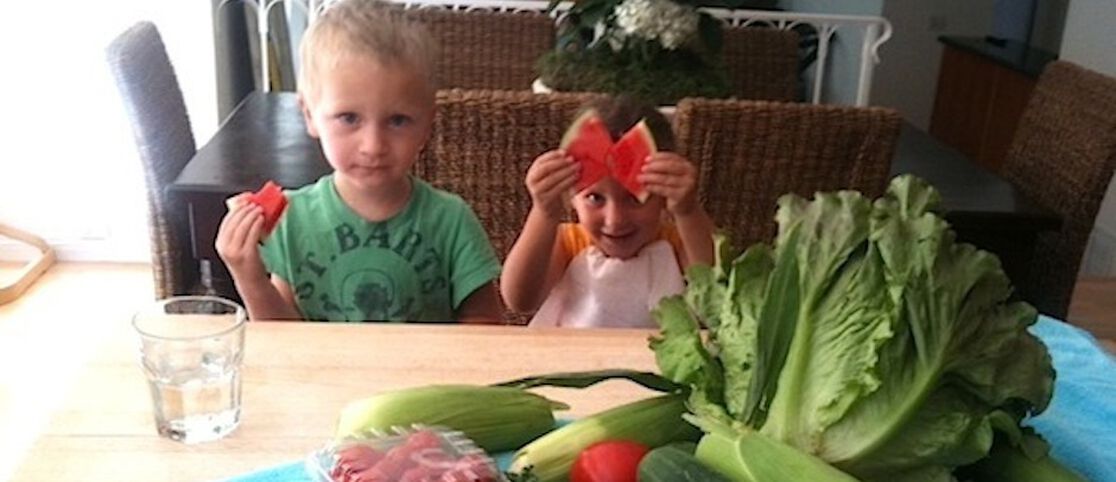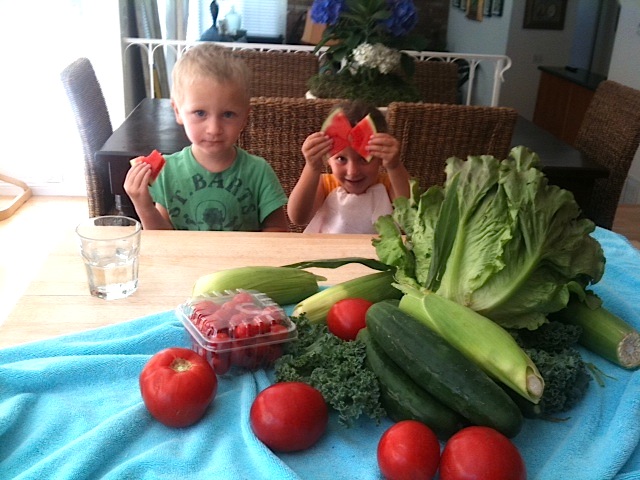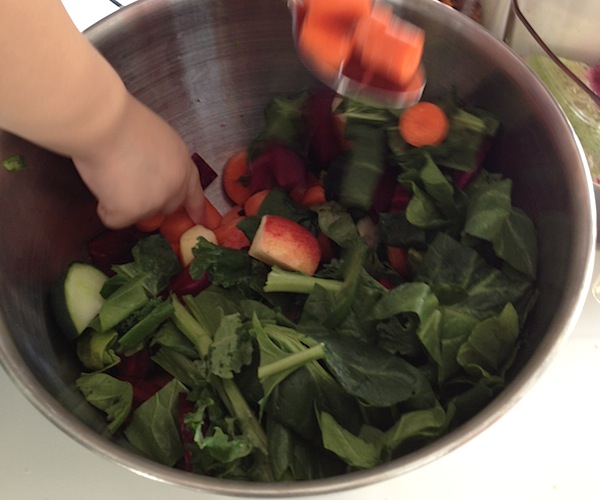For most of us, we know that we (including our kids) should be eating MANY servings of fruits and veggies each day. We’ve heard it over and over: Make half your plate fruits and veggies, eat brightly colored produce for the most nutrient power, “5 to 9-A-Day,” and on and on. For most, increasing fruit consumption is easier than increasing vegetable consumption. We know that vegetables are good for us, but why do our kids—and sometimes adults—refuse them and how can we help them eat more?
Few foods elicit such anxiety in parents and fear in children as the dreaded green monster—the vegetable. Okay, I know what you are thinking. They’re not all green, but the most feared ones are green! Why are these vitamin, mineral, and antioxidant packed foods so often refused? Vegetables are a complex food with a strong and sometimes bitter flavor. Children’s taste buds are far more sensitive than adults, especially for bitter tastes. A mouthful of cabbage or broccoli will have a far stronger taste for a child. Some studies have shown that preference for fruits or vegetables is genetic. The good news is that studies also have indicated that children can learn to like vegetables, but it is usually a matter of time and presentation. (If your child has a feeding disorder or an extremely limited repertoire and you’re worried about their nutritional status, please contact your child’s pediatrician.)
What works for encouraging children to eat vegetables?
Eat vegetables. What a mother eats when pregnant and especially when breastfeeding her baby influences an infant’s food preference. Watching parents enjoy eating vegetables will encourage children to do so too. So, if you want your child to eat vegetables, you need to eat them.
Familiarity. Offer vegetables frequently. Don’t expect a child to eat the vegetable the first time you serve it. Let the first encounter be a “getting to know you” experience. For many foods, it takes 10-20 “introductions” before a food becomes part of the child’s food repertoire. Some cookbooks suggest sneaking vegetables into food. This may be helpful for introducing the flavor, BUT not helpful for encouraging a long-term acceptance of vegetables. Instead of “hiding” carrots in the cake, make carrot cake with your child and let your child know that this is just another way to eat carrots. Sneaking veggies into sweets also can teach the wrong message. By encouraging consumption of broccoli infused brownies, you also might be encouraging consumption of regular high-fat and sugar-rich brownies as well. Eating is a relationship built on trust and sneaking undermines that trust.
Don’t demonize vegetables. Bribery, forcing, demanding, rewarding —all of these techniques surprisingly make vegetables very unattractive. If your child has to eat the cauliflower before s/he can have the ice cream, your child may begin to dislike the cauliflower even if s/he liked it before because the cauliflower becomes a barrier to the dessert. It also teaches them that certain foods have more value than others—ice cream is “better” than cauliflower.
Presentation. Children are also very sensitive to the texture of foods. Do you think your child would like a crunchy cucumber or a soft sweet potato? Think about how you are serving the vegetable.
Overcooked vegetables can be mushy and bitter. Fruit-loving children often prefer milder or sweeter vegetables such as cucumbers, carrots, corn, sweet potato, or cauliflower. Sometimes raw carrots, broccoli, or cauliflower are just too hard to chew for younger children. Lightly steam them first and then keep in the refrigerator for easy access. Make a rainbow salad with your child, together you can slice, toss, and mix. Try new vegetables or have a different color vegetable each night. Try shredded purple cabbage with poppy-seed dressing or open up some fresh pea pods and count the peas inside.
Look at the books Play with Your Food or Food Play by Joost Elffers or Entertaining Edibles by Sidney Escowitz, then try to make them at home. Be positive about the color, flavor, texture, and smell as you explore new and different colorful vegetables. Call them cute names like broccoli trees and carrot coins to make it fun!
Rainbow Citrus Slaw Salad: Serves 6
Adapted from “Fast, Fun & Fit . . . Food for Your Family Vegetable Recipes” by the California Department of Health Services
Read the Book Cabbage Moon by Tim Chadwick and Piers Harper, then have your child help you make the salad
Ingredients
Dressing: 1⁄4 cup rice vinegar + 1⁄4 cup orange juice
Salad: 1 cup of shredded Nappa cabbage; 1 cup of shredded purple cabbage; 2 cups of shredded dark green leafy lettuce or kale; 2 oranges peeled and segmented; 1 red apple, halved, cored and diced; 1⁄2 cup shredded carrots.
Optional: 1⁄4 cup sliced green onions or sprinkle of toasted almonds.
Directions
In a large bowl mix rice vinegar and the orange juice. Add remaining ingredients. Toss thoroughly.
~ Nicole Meadow, MPN, RD
We aim to provide you with the most honest and credible information possible. This article was reviewed for accuracy by The Honest Team and its internal technical experts.
blog_review_statement






